1994 FIFA World Cup
The 1994 FIFA World Cup was the 15th FIFA World Cup, the world championship for men's national soccer teams. It was hosted by the United States and took place from June 17 to July 17, 1994, at nine venues across the country. The United States was chosen as the host by FIFA on July 4, 1988. Despite soccer's relative lack of popularity in the host nation, the tournament was the most financially successful in World Cup history; it broke tournament records with overall attendance of 3,587,538 and an average of 68,991 per match[1], marks that stood unbroken as of 2018[2] despite the expansion of the competition from 24 to 32 teams starting with the 1998 World Cup.[3]
| World Cup USA '94 | |
|---|---|
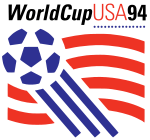 1994 FIFA World Cup official logo | |
| Tournament details | |
| Host country | United States |
| Dates | June 17 – July 17 |
| Teams | 24 (from 5 confederations) |
| Venue(s) | 9 (in 9 host cities) |
| Final positions | |
| Champions | |
| Runners-up | |
| Third place | |
| Fourth place | |
| Tournament statistics | |
| Matches played | 52 |
| Goals scored | 141 (2.71 per match) |
| Attendance | 3,597,042 (69,174 per match) |
| Top scorer(s) | (6 goals each) |
| Best player(s) | |
| Best young player | |
| Best goalkeeper | |
| Fair play award | |
Brazil won the tournament after beating Italy 3–2 in a penalty shoot-out at the Rose Bowl in Pasadena, California near Los Angeles, after the game had ended 0–0 after extra time. It was the first World Cup final to be decided on penalties. The victory made Brazil the first nation to win four World Cup titles. There were three new entrants in the tournament: Greece, Nigeria and Saudi Arabia plus Russia, following the breakup of the Soviet Union, and for the first time since 1938, a unified Germany took part in the tournament.
Background and preparations

Three nations bid for host duties: United States, Brazil, and Morocco.[4] The vote was held in Zurich on July 4, 1988, and only took one round with the United States bid receiving a little over half of the votes by the Exco members.[4] FIFA hoped that by staging the world's most prestigious tournament there, it would lead to a growth of interest in the sport. An inspection committee also found that the proposed Brazilian stadiums were deficient, while the Moroccan bid relied on the construction of nine new stadiums. Conversely, all the proposed stadiums in the United States were already built and fully functioning; US Soccer spent $500 million preparing and organizing the tournament, far less than the billions other countries previously had spent and subsequently would spend on preparing for this tournament.[5] The U.S. bid was seen as the favorite and was prepared in response to losing the right to be the replacement host for the 1986 tournament following Colombia's withdrawal.[6]
One condition FIFA imposed was the creation of a professional soccer league—Major League Soccer was founded in 1993 and began operating in 1996. There was some initial controversy about awarding the World Cup to a country where soccer was not a nationally popular sport, and at the time, in 1988, the U.S. no longer had a professional league; the North American Soccer League, established in the 1960s, had folded in 1984 after attendance faded. The success of the 1984 Summer Olympics, particularly the soccer tournament, also contributed to FIFA's decision.
Mascot
The official mascot of this World Cup was Striker, the World Cup Pup, a dog wearing a red, white and blue soccer uniform with a ball.[7] Striker was designed by the Warner Bros. animation team.[8] A dog was picked as the mascot because dogs are a common pet in the United States.[8]
Sponsorship
The sponsors of the 1994 FIFA World Cup are divided into two categories: FIFA World Cup Sponsors and USA supporters.
| FIFA World Cup sponsors | USA supporters |
|---|---|
The official game ball was the Adidas Questra.
Venues
The games were played in nine cities across the United States. All stadiums had a capacity of at least 53,000, and their usual tenants were professional or college American football teams.[12] Other considered venues in Atlanta, Denver, Kansas City, Las Vegas, Miami, Minneapolis, New Orleans, Philadelphia, Seattle and Tampa were not used, as well as venues in smaller towns such as Annapolis, Maryland; Columbus, Ohio; Corvallis, Oregon; and New Haven, Connecticut.[13] Several modern venues, including Joe Robbie Stadium in Miami and Candlestick Park in San Francisco were rejected because of conflicts with Major League Baseball, so Stanford Stadium, 20 miles (32 km) southeast of San Francisco was used,[14][15] and the Citrus Bowl in Orlando was picked over Miami's two submitted venues (the Orange Bowl, the other Miami venue, required major renovations to meet tournament standards).[16] The venue used most was the Rose Bowl in Pasadena, with eight games, among them one round of 16 match, a semi-final, the third-place game, and the final. Giants Stadium near New York hosted seven matches including a semi-final; Boston (Foxborough), San Francisco (Stanford) and Dallas hosted six matches each and Chicago, Washington and Orlando each hosted five matches. The least used was the Pontiac Silverdome near Detroit, the first indoor stadium used in a World Cup, with four group stage games. The Pontiac Silverdome was also the only venue of the nine used that did not host any knockout round matches.
Because of the large area of the continental United States, the match locations were often far apart. Some teams in Groups A and B had to travel from Los Angeles or San Francisco all the way to Detroit and back again, covering 2,300 miles (3,700 km) and three time zones one way. The teams in Groups C and D only played in Foxborough (Boston), Chicago and Dallas – a trip from Boston to Dallas is 2,000 miles (3,200 km), but only covers two time zones; Chicago is in the same time zone as Dallas but is still 1,000 miles (1,600 km) away from both Dallas and Boston. The teams in Groups E and F had it a bit easier – they played exclusively in East Rutherford (New York City), Washington and Orlando, which while far apart are at least all in the same time zone. A few teams, such as Cameroon and Italy, did not have to travel great distances to cities to play matches.
The variety of climate in different cities all over the United States also sometimes made playing conditions challenging. Aside from the oceanic coolness of Boston (Foxborough), the Mediterranean climate of San Francisco (Stanford) and occasionally the coolness of Chicago, as they had been in Mexico in 1970 and 1986 most matches were played in hot and/or humid conditions, thanks to nearly all of the matches being scheduled to be played during the day instead of at night in order to suit a time difference compromise for television in Europe, Africa, and the Middle East; this had always been done every time a World Cup was held in the Americas. Although playing in the mostly dry heat and smoggy conditions of Los Angeles (Pasadena) and the mixture of heat and humidity of Washington and New York City (East Rutherford) proved to be difficult, the cities with the most oppressive conditions were the southern cities of Orlando and Dallas in Texas and Florida respectively because of the combination of heat and extreme humidity.[17] The Floridian tropical climate of Orlando meant all matches there were played in temperatures of 95 °F (35 °C) or above with humidity at 70% or more (the temperature there during the group stage match between Mexico and Ireland was 105 °F (41 °C)) thanks to the mid-day start times.[18] Dallas was not much different: in the semi-arid heat of a Texas summer, temperatures exceeded 100 °F (38 °C) during mid-day, when matches there were staged in the open-type Cotton Bowl meant that conditions were just as oppressive there as they were in Orlando.[19] Detroit also proved to be difficult: the Pontiac Silverdome did not have a working cooling system and because it was an interior dome-shaped stadium, the air could not escape through circulation, so temperatures inside the stadium would climb past 90 °F (32 °C) with 40% humidity. United States midfielder Thomas Dooley described the Silverdome as "the worst place I have ever played at".[20]
| Pasadena, California (Los Angeles) |
Stanford, California (San Francisco) |
Pontiac, Michigan (Detroit) |
East Rutherford, New Jersey (New York/New Jersey) |
|---|---|---|---|
| Rose Bowl | Stanford Stadium | Pontiac Silverdome | Giants Stadium |
| Capacity: 94,194 | Capacity: 84,147 | Capacity: 77,557 | Capacity: 76,322 |
_(cropped).jpg) |
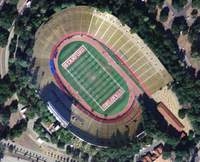 |
 |
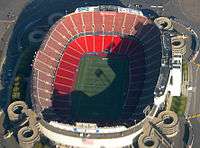 |
| Dallas | 1994 FIFA World Cup (the United States) | ||
| Cotton Bowl | |||
| Capacity: 64,000 | |||
 | |||
| Chicago | Orlando | Foxborough, Massachusetts (Boston) |
Washington, D.C. |
| Soldier Field | Citrus Bowl | Foxboro Stadium | Robert F. Kennedy Memorial Stadium |
| Capacity: 63,160 | Capacity: 62,387 | Capacity: 54,456 | Capacity: 53,121 |
 |
 |
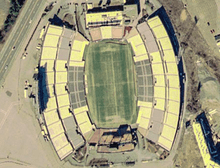 |
|
Participating teams and officials
Qualification
Three teams, one African, one Asian, and one European, made their debuts at the 1994 tournament. Nigeria qualified from the African zone alongside Cameroon and Morocco as CAF was granted three spots as a result of the strong performances by African teams in 1990. In the Asian zone, Saudi Arabia qualified for the first time by topping the final round group ahead of South Korea as both edged out Japan, who were close to making their own World Cup debut, but were denied by Iraq in what became known as the "Agony of Doha". The Japanese would not have to wait long though, debuting in the 1998 tournament. In the European zone, Greece made their first World Cup appearance after topping a group from which Russia also qualified, competing independently for the first time after the dissolution of the Soviet Union.
The defending champions West Germany were united with their East German counterparts, representing the unified Germany for the first time since the 1938 World Cup. Norway qualified for the first time since 1938, Bolivia for the first time since 1950, and Switzerland for the first time since 1966. Norway's 56-year gap between appearances in the final tournament equaled Egypt's record in the previous tournament as the longest. Mexico had its first successful qualification campaign since 1978, failing to qualify in 1982, qualifying as hosts in 1986 and being banned for the Cachirules scandal in 1990.
The qualification campaigns of both Czechoslovakia and Yugoslavia were affected by political events. The nation of Czechoslovakia dissolved in 1993, completing its qualifying group under the name "Representation of Czechs and Slovaks" (RCS), but failed to qualify for the finals, having been edged out by Romania and Belgium in Group 4. Yugoslavia (which was supposed to play in Group 5) was suspended from international competition in 1992 as part of United Nations sanctions against the country as a result of the Yugoslav Wars. The sanctions were not lifted until 1994, by which time it was no longer possible for the team to qualify. Chile's suspension from the 1990 FIFA World Cup, following the forced interruption of their qualification game against Brazil, extended to the 1994 qualifiers as well.
This was the first World Cup since World War II in which none of the Home Nations of England, Scotland, Northern Ireland and Wales qualified (they withdrew their FIFA memberships between 1928–1946, during the first three tournaments), with England (finishing third behind Norway and Netherlands in Group 2) missing out after having finished fourth in the 1990 tournament, and Scotland (who finished fourth in Group 1) failing to qualify for the first time since 1970. France, who had been already designated as hosts of the 1998 tournament, also missed out following surprise home losses to Israel and Bulgaria. This was the second World Cup in a row for which France had failed to qualify, and the last one to date to not feature England, France, and Japan. Other notable absentees were 1990 Round of 16 participants Uruguay, UEFA Euro 1992 champions Denmark, Poland, Portugal and Hungary.
List of qualified teams
The following 24 teams, shown with final pre-tournament rankings,[21] qualified for the final tournamentː
|
|
|
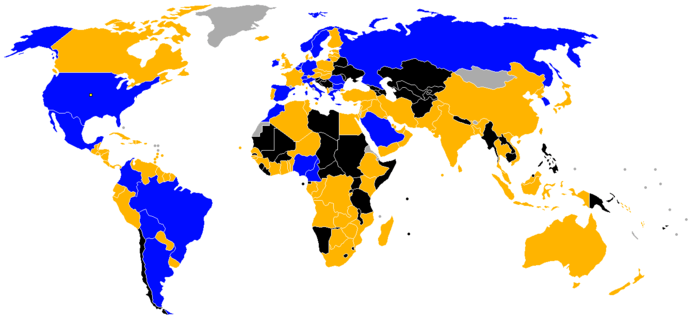 Countries qualified for World Cup Country failed to qualify Countries that did not enter or were banned from the World Cup Country not a FIFA member
|
Squads
Teams were selected following usual FIFA rules with 22 players. Greece, Italy, Saudi Arabia, and Spain were the only countries that had all their players coming from domestic teams, while the Republic of Ireland and Nigeria had no players from domestic teams. Saudi Arabia was the only team with no players from European teams.
Seeding and draw
The composition of the four pots was based on the FIFA World Ranking (established in 1993) and on the qualified teams' results in the three previous World Cups. The teams' pre-tournament rankings[22] are shown in parenthesis. The principle of the draw was that each group must have at least two European teams, USA and Mexico could not be drawn in the same group, and Brazil and Argentina could not be drawn with another South American team.
| Pot 1 (Top 5 plus hosts) | Pot 2 (Africa + Americas) | Pot 3 (Europe 1–6) | Pot 4 (Europe 7–10 + Asia) |
|---|---|---|---|
|
|
The draw for the tournament took place at the Las Vegas Convention Center on December 19, 1993, officiated by general-secretary Sepp Blatter. Teams were drawn by German legend Franz Beckenbauer, heavyweight boxing champion Evander Holyfield and comedian and actor Robin Williams. Numbers for placement in the group were drawn by actor Beau Bridges, Women's World Cup champion Michelle Akers, model Carol Alt, artist Peter Max, racecar driver Mario Andretti and Olympic gold medalist in gymnastics Mary Lou Retton.[23][24]
Summary
Despite the controversy, the U.S. staged a hugely successful tournament, with an average attendance of nearly 70,000 breaking a record that surpassed the 1966 FIFA World Cup average attendance of 51,000, thanks to the large seating capacities the stadiums in the United States provided for the spectators in comparison to the smaller venues of Europe and Latin America. To this day, the total attendance for the final tournament of nearly 3.6 million remains the highest in World Cup history, despite the expansion of the competition from 24 to 32 teams at the 1998 World Cup in France.[2][25] Germany, Brazil, Argentina, Belgium, Italy, and the United States were seeded for the final draw, which took place in Las Vegas on December 19, 1993.[26]
The format of the competition stayed the same as in the 1990 World Cup: 24 teams qualified, divided into six groups of four. Sixteen teams would qualify for the knockout phase: the six group winners, the six group runners-up, and the four third-placed teams with the best records. This was the last time this format was used, due to the expansion of the finals tournament in 1998 to 32 teams. This World Cup was the first in which three points were awarded for a win instead of two. FIFA instituted this feature to encourage attacking soccer after the defensive display of many teams at Italia '90.
The tournament saw the end of Diego Maradona's World Cup career, having played in the 1982, 1986, and 1990 World Cups, and leading Argentina to the 1986 World Cup title and the final of the 1990 World Cup. Maradona was expelled from the tournament after he failed a drug test which uncovered ephedrine, a weight-loss drug, in his blood. Colombia, despite high expectations due to their style and impressive qualifying campaign, failed to advance from the round robin. The team was supposedly dogged by influence from betting syndicates and drug cartels, with coach Francisco Maturana receiving death threats over squad selection. Defender Andrés Escobar was a tragic figure of this tournament, as in the group stage game against the United States, he scored an own goal that eliminated his team. Escobar was shot to death outside a bar in a Medellín suburb only 10 days later, apparently in retaliation for the own goal.[27]
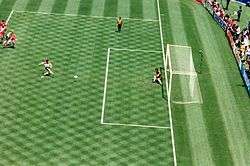
On the field, Bulgaria was one of the biggest surprises of the tournament. The Bulgarians had never won a game in five previous World Cup finals but, led by Hristo Stoichkov who eventually shared the tournament lead in scoring, they made a surprising run; Bulgaria won two of their three group games to qualify for the second round, where they advanced with a 3–1 penalty shoot-out win over Mexico. Bulgaria then faced the reigning world champions, Germany, in the quarter-finals, where goals from Stoichkov and Yordan Letchkov gave them a 2–1 victory. Bulgaria went on to finish in fourth place after losing to Italy and Sweden, in the semi-finals and third-place game, respectively.
The United States, relatively new to professional football, advanced to the second round as one of the best third-place teams. They played Brazil on Independence Day and, despite a 1–0 defeat, the United States' performance was considered a great success in their football history.
Brazil's win over the hosts helped take them to the final against Italy. Brazil's path was relatively smooth though not easy, as they defeated the Netherlands in the quarter-finals and Sweden in the semis. The Italians meanwhile had made hard work of reaching the final. During the group stage, Italy struggled and narrowly advanced to the next round, despite losing 1–0 to the Republic of Ireland. Italian playmaker Roberto Baggio, who as the reigning FIFA World Player of the Year and Ballon D'Or holder, was expected to be one of the stars of the tournament, had not yet scored a goal. During the Round of 16 games against Nigeria, Italy was trailing 1–0 in the dying minutes when Baggio scored the tying goal, forcing the game into extra time. He scored again with a penalty kick to send Italy through. Baggio carried the Italians from there, scoring the game-winning goal in the quarter-final against Spain, and both goals in Italy's semi-final victory over Bulgaria.[28]
The third-place playoff was set between Bulgaria and Sweden, the team which scored more goals than any other in this World Cup. These teams had also previously met in the qualifying group. Sweden won, 4–0. Swedish forward Tomas Brolin was named to the All-star team.[29]
The final game at the Rose Bowl was tense but devoid of scoring chances. It was the second time in 24 years that the two nations had met in a final. Despite the strategies implemented by FIFA to promote offensive play, both teams failed to produce a goal. After 120 goalless minutes, the World Cup was decided for the first time by a penalty shoot-out. After four rounds, Brazil led 3–2, and Baggio, playing injured, had to score to keep Italy's hopes alive.[28] He missed by shooting it over the crossbar, and the Brazilians were crowned champions for the fourth time.[30] After the game ended, then-Vice-President Al Gore hosted the awarding ceremony by handing Brazilian captain Dunga the prestigious trophy; the Brazilian national team dedicated the title to the deceased Formula One motor racing champion and countryman Ayrton Senna, who had died two and a half months prior.
The tournament's Golden Boot went jointly to Bulgaria's Stoichkov and Oleg Salenko of Russia, the latter becoming the first player to score five goals in a game, coming in a 6–1 victory against Cameroon. Both players scored six goals in the tournament. Brazilian striker Romário, with five goals, won the Golden Ball as the tournament's best player.[30]
Opening ceremony
The opening ceremony of the World Cup was held on June 17 at Chicago's Soldier Field. The ceremony was emceed by Oprah Winfrey, who fell off the dais in introducing Diana Ross, who gave a musical performance. Ross was also supposed to kick a football into the goal from the penalty spot at the beginning of her performance, with the goal then splitting in two as part of a pre-orchestrated stunt. She kicked the ball wide to the left, missing the goal, but the goalposts were collapsed anyway in accordance with the stunt plans. In addition, Daryl Hall and Jon Secada also gave musical performances.[31]
Group stage
Times are Eastern Daylight Time (UTC−4) (East Rutherford, Foxborough, Orlando, Pontiac and Washington), Central Daylight Time (UTC−5) (Chicago and Dallas), and Pacific Daylight Time (UTC−7) (Pasadena and Stanford).
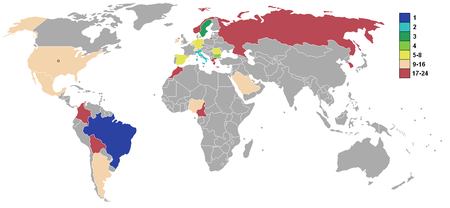
Champion Runner-up |
Third place Fourth place |
Quarter-finals Round of 16 |
Group stage |
In the following tables:
- Pld = total games played
- W = total games won
- D = total games drawn (tied)
- L = total games lost
- GF = total goals scored (goals for)
- GA = total goals conceded (goals against)
- GD = goal difference (GF−GA)
- Pts = total points accumulated
Group A
The Group A game between the United States and Switzerland was the first to take place indoors, played under the roof at the Pontiac Silverdome.
Following the tournament, Colombian defender Andrés Escobar was shot dead on his return to Colombia, after his own goal had contributed to his country's elimination.
Victories against Colombia and the United States (in front of a crowd of 93,869) were enough to see Romania through as group winners, despite a 4–1 hammering by Switzerland in between. The magnitude of that victory allowed Switzerland to move ahead of the United States on goal difference, although the hosts qualified for the second round as one of the best third-placed teams.
Switzerland's 4–1 victory over Romania came nearly 40 years to the date of Switzerland's last World Cup victory, also a 4–1 victory, on that occasion over Italy. The United States' 2–1 victory over Colombia was its first World Cup victory since June 29, 1950 when it upset England 1–0 in the 1950 World Cup.
| Pos | Team | Pld | W | D | L | GF | GA | GD | Pts | Qualification |
|---|---|---|---|---|---|---|---|---|---|---|
| 1 | 3 | 2 | 0 | 1 | 5 | 5 | 0 | 6 | Advance to knockout stage | |
| 2 | 3 | 1 | 1 | 1 | 5 | 4 | +1 | 4 | ||
| 3 | 3 | 1 | 1 | 1 | 3 | 3 | 0 | 4 | ||
| 4 | 3 | 1 | 0 | 2 | 4 | 5 | −1 | 3 |
| June 18, 1994 | |||
| United States | 1–1 | Pontiac Silverdome, Pontiac | |
| Colombia | 1–3 | Rose Bowl, Pasadena | |
| June 22, 1994 | |||
| Romania | 1–4 | Pontiac Silverdome, Pontiac | |
| United States | 2–1 | Rose Bowl, Pasadena | |
| June 26, 1994 | |||
| Switzerland | 0–2 | Stanford Stadium, Stanford | |
| United States | 0–1 | Rose Bowl, Pasadena |
Group B
Group B produced two of the four semi-finalists of this World Cup — Brazil and Sweden — and was also one of the two groups in which only two, rather than three, sides progressed to the second round. The match between the two eliminated teams, Cameroon and Russia, broke two World Cup records. Oleg Salenko of Russia became the first – and remains the only – man to score five goals in a single World Cup game as Russia won 6–1. The goals also ensured that Salenko finished the tournament joint-top scorer with six goals, having previously bagged one against Sweden. Cameroon left a mark too as Roger Milla, at the age of 42, became the oldest World Cup goalscorer of all time, as he grabbed his side's consolation goal in the game. The result was not enough to take Russia through following losses to Brazil and Sweden. Brazil beat Cameroon, and then confirmed the top spot with a draw to Sweden.
The Swedes also progressed, finishing in second place with five points. Sweden's 3–1 victory over Russia was the nation's first World Cup victory since July 3, 1974. Russia failed to progress to the second round for the second time, while Cameroon failed to repeat their surprise performance from the previous tournament.
| Pos | Team | Pld | W | D | L | GF | GA | GD | Pts | Qualification |
|---|---|---|---|---|---|---|---|---|---|---|
| 1 | 3 | 2 | 1 | 0 | 6 | 1 | +5 | 7 | Advance to knockout stage | |
| 2 | 3 | 1 | 2 | 0 | 6 | 4 | +2 | 5 | ||
| 3 | 3 | 1 | 0 | 2 | 7 | 6 | +1 | 3 | ||
| 4 | 3 | 0 | 1 | 2 | 3 | 11 | −8 | 1 |
| June 19, 1994 | |||
| Cameroon | 2–2 | Rose Bowl, Pasadena | |
| June 20, 1994 | |||
| Brazil | 2–0 | Stanford Stadium, Stanford | |
| June 24, 1994 | |||
| Brazil | 3–0 | Stanford Stadium, Stanford | |
| Sweden | 3–1 | Pontiac Silverdome, Pontiac | |
| June 28, 1994 | |||
| Russia | 6–1 | Stanford Stadium, Stanford | |
| Brazil | 1–1 | Pontiac Silverdome, Pontiac |
Group C
As was the case with Group B, Group C would only send two teams into the Round of 16 as Spain and defending champions Germany progressed to round two. Coming from two goals down with four minutes left to snatch a 2–2 draw against Spain, the South Koreans very nearly eclipsed that feat against Germany when they came from 3–0 down to lose narrowly 3–2. In spite of these comebacks, South Korea was held to a 0–0 draw against Bolivia in their other group game when a win would have seen them through. Spain's late implosion against the South Koreans effectively decided that it would be Germany who won the group and not them.
Germany, who defeated Bolivia 1–0 in the tournament's opening game, finished with seven points. Spain had to settle for second place despite leading in all three games.
Despite Bolivia finishing last in the group, Erwin Sanchez made team history after scoring the nation's first World Cup goal in a 3–1 loss to Spain. Prior to 1994, Bolivia had never scored in either of their previous appearances at the 1930 and 1950 World Cups.
| Pos | Team | Pld | W | D | L | GF | GA | GD | Pts | Qualification |
|---|---|---|---|---|---|---|---|---|---|---|
| 1 | 3 | 2 | 1 | 0 | 5 | 3 | +2 | 7 | Advance to knockout stage | |
| 2 | 3 | 1 | 2 | 0 | 6 | 4 | +2 | 5 | ||
| 3 | 3 | 0 | 2 | 1 | 4 | 5 | −1 | 2 | ||
| 4 | 3 | 0 | 1 | 2 | 1 | 4 | −3 | 1 |
| June 17, 1994 | |||
| Germany | 1–0 | Soldier Field, Chicago | |
| Spain | 2–2 | Cotton Bowl, Dallas | |
| June 21, 1994 | |||
| Germany | 1–1 | Soldier Field, Chicago | |
| June 23, 1994 | |||
| South Korea | 0–0 | Foxboro Stadium, Foxborough | |
| June 27, 1994 | |||
| Bolivia | 1–3 | Soldier Field, Chicago | |
| Germany | 3–2 | Cotton Bowl, Dallas |
Group D
Tournament favorites Argentina led by Diego Maradona collected a maximum of six points from their opening two games after dominating Greece 4–0 in Foxboro with a Gabriel Batistuta hattrick before winning a close match against a formidable Nigeria with a 2–1 victory on the same field four days later; despite this Argentina finished third in the group. Nigeria had been very impressive on their World Cup debut, and despite the narrow loss to Argentina, had emerged as group winners following victories against Bulgaria and Greece, the latter in which Nigeria doubled its lead late on a goal from Daniel Amokachi – a goal that would allow Nigeria to top its group. Maradona only played with Argentina during their first two games, both in Foxborough (playing Greece and Nigeria and scoring his last ever World Cup goal against the former); he was thrown out of the tournament after testing positive for ephedrine.
Having qualified for the tournament through a last-gasp goal against France, Bulgaria surprised many people, as the nation had never even won a game at the World Cup finals prior to this tournament. Despite losing its opening game 3–0 to Nigeria, Bulgaria came back in style with a 4–0 win over Greece (who had suffered exactly the same fate five days earlier against Argentina), and a 2–0 win against Argentina saw them advance. Argentina had actually been winning the group going into injury time, while Bulgaria played the last 25 minutes with 10 men; however, a 91st-minute header from Nasko Sirakov meant that Argentina dropped two places and finished third. Nigeria won the group on goal difference. Bulgaria's victory over Argentina earned them second place.
| Pos | Team | Pld | W | D | L | GF | GA | GD | Pts | Qualification |
|---|---|---|---|---|---|---|---|---|---|---|
| 1 | 3 | 2 | 0 | 1 | 6 | 2 | +4 | 6 | Advance to knockout stage | |
| 2 | 3 | 2 | 0 | 1 | 6 | 3 | +3 | 6 | ||
| 3 | 3 | 2 | 0 | 1 | 6 | 3 | +3 | 6 | ||
| 4 | 3 | 0 | 0 | 3 | 0 | 10 | −10 | 0 |
| June 21, 1994 | |||
| Argentina | 4–0 | Foxboro Stadium, Foxborough | |
| Nigeria | 3–0 | Cotton Bowl, Dallas | |
| June 25, 1994 | |||
| Argentina | 2–1 | Foxboro Stadium, Foxborough | |
| June 26, 1994 | |||
| Bulgaria | 4–0 | Soldier Field, Chicago | |
| June 30, 1994 | |||
| Argentina | 0–2 | Cotton Bowl, Dallas | |
| Greece | 0–2 | Foxboro Stadium, Foxborough |
Group E
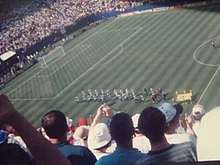
Group E remains the only group in World Cup history in which all four teams finished with the same points and same goal difference. It began at Giants Stadium where Ray Houghton's chip ensured a shock Irish victory over the then-three-time champions Italy by 1–0, as well as gaining a measure of revenge for the previous World Cup, in which Italy both hosted and eliminated Ireland at quarter-finals. The next day in Washington, Norway played its first World Cup game since 1938 and Kjetil Rekdal's goal five minutes from time proved decisive in an equally tense encounter as Norway beat Mexico.
In the second round of group play, the tropical weather of Orlando played a key factor for Mexico in their next game against Ireland. The match was held in record-breaking heat and humidity, temperatures in which the Mexicans were accustomed to but visibly uncomforted the Irish. Luis García's double had them 2–0 up and in control of the game before a disagreement on the touchline resulted in fines for both Republic of Ireland's manager, Jack Charlton, and their striker John Aldridge. Aldridge was able to regain concentration in time to score six minutes from the end of the game to make it 2–1. Despite their loss, Aldridge's goal proved crucial to Ireland in the final group standings.
During the previous day at Giants Stadium in New Jersey, Italy's World Cup hopes seemed to be diminishing fast as goalkeeper Gianluca Pagliuca was sent off with the game still at 0–0. Yet despite this, Italy was still able to salvage an important 1–0 victory. Norway would ultimately pay a price for their inability to take advantage of Pagliuca's dismissal. With the four teams level on points, the final two group games would each have to finish as draws for things to stay that way. Republic of Ireland made it through after a dreary 0–0 draw with Norway; midfielders Massaro and Bernal traded strikes as Italy and Mexico played to a 1–1 draw.
Those results meant that Mexico won the group on goals scored, with three in the group. With Ireland and Italy also progressing having finished with identical records, the Irish team qualified as second place as a result of their victory against the Italians. Norway's shortcomings in attack ultimately let them down, and they exited the tournament with only one goal.
| Pos | Team | Pld | W | D | L | GF | GA | GD | Pts | Qualification |
|---|---|---|---|---|---|---|---|---|---|---|
| 1 | 3 | 1 | 1 | 1 | 3 | 3 | 0 | 4 | Advance to knockout stage | |
| 2 | 3 | 1 | 1 | 1 | 2 | 2 | 0 | 4 | ||
| 3 | 3 | 1 | 1 | 1 | 2 | 2 | 0 | 4 | ||
| 4 | 3 | 1 | 1 | 1 | 1 | 1 | 0 | 4 |
| June 18, 1994 | |||
| Italy | 0–1 | Giants Stadium, East Rutherford | |
| June 19, 1994 | |||
| Norway | 1–0 | RFK Stadium, Washington | |
| June 23, 1994 | |||
| Italy | 1–0 | Giants Stadium, East Rutherford | |
| June 24, 1994 | |||
| Mexico | 2–1 | Citrus Bowl, Orlando | |
| June 28, 1994 | |||
| Italy | 1–1 | RFK Stadium, Washington | |
| Republic of Ireland | 0–0 | Giants Stadium, East Rutherford |
Group F
Just as happened to Argentina in Group D, Belgium endured the same fate in Group F. Despite winning both of its first two matches 1–0 against Morocco and neighbors Netherlands, Belgium finished third as, in an upset, it lost to tournament newcomers Saudi Arabia 1–0 in the third game. During that game, Saudi player Saaed Al-Owairian ran from his own half through a maze of Belgian players to score the game's only goal.
Saudi Arabia advanced through to the Round of 16 as well, having also defeated Morocco 2–1. The Netherlands endured a somewhat nervier experience. The opening 2–1 victory against Saudi Arabia was followed by the 1–0 loss against Belgium before another 2–1 victory against Morocco, with Bryan Roy scoring the winner a mere 12 minutes from time, saw the Dutch win the group because of having scored more goals against Belgium and Saudi Arabia. Morocco, despite losing all three of their group games, did not leave without a fight, as each of their losses were by just a single goal, 1–0 to Belgium, 2–1 to Saudi Arabia, and 2–1 to the Netherlands.
| Pos | Team | Pld | W | D | L | GF | GA | GD | Pts | Qualification |
|---|---|---|---|---|---|---|---|---|---|---|
| 1 | 3 | 2 | 0 | 1 | 4 | 3 | +1 | 6 | Advance to knockout stage | |
| 2 | 3 | 2 | 0 | 1 | 4 | 3 | +1 | 6 | ||
| 3 | 3 | 2 | 0 | 1 | 2 | 1 | +1 | 6 | ||
| 4 | 3 | 0 | 0 | 3 | 2 | 5 | −3 | 0 |
| June 19, 1994 | |||
| Belgium | 1–0 | Citrus Bowl, Orlando | |
| June 20, 1994 | |||
| Netherlands | 2–1 | RFK Stadium, Washington | |
| June 25, 1994 | |||
| Saudi Arabia | 2–1 | Giants Stadium, East Rutherford | |
| Belgium | 1–0 | Citrus Bowl, Orlando | |
| June 29, 1994 | |||
| Belgium | 0–1 | RFK Stadium, Washington | |
| Morocco | 1–2 | Citrus Bowl, Orlando |
Ranking of third-placed teams
| Pos | Grp | Team | Pld | W | D | L | GF | GA | GD | Pts | Qualification |
|---|---|---|---|---|---|---|---|---|---|---|---|
| 1 | D | 3 | 2 | 0 | 1 | 6 | 3 | +3 | 6 | Advance to knockout stage | |
| 2 | F | 3 | 2 | 0 | 1 | 2 | 1 | +1 | 6 | ||
| 3 | A | 3 | 1 | 1 | 1 | 3 | 3 | 0 | 4 | ||
| 4 | E | 3 | 1 | 1 | 1 | 2 | 2 | 0 | 4 | ||
| 5 | B | 3 | 1 | 0 | 2 | 7 | 6 | +1 | 3 | ||
| 6 | C | 3 | 0 | 2 | 1 | 4 | 5 | −1 | 2 |
Knockout stage
| Round of 16 | Quarter-finals | Semi-finals | Final | |||||||||||
| 3 July – Pasadena | ||||||||||||||
| 3 | ||||||||||||||
| 10 July – Stanford | ||||||||||||||
| 2 | ||||||||||||||
| 2 (4) | ||||||||||||||
| 3 July – Dallas | ||||||||||||||
| 2 (5) | ||||||||||||||
| 1 | ||||||||||||||
| 13 July – Pasadena | ||||||||||||||
| 3 | ||||||||||||||
| 0 | ||||||||||||||
| 4 July – Orlando | ||||||||||||||
| 1 | ||||||||||||||
| 2 | ||||||||||||||
| 9 July – Dallas | ||||||||||||||
| 0 | ||||||||||||||
| 2 | ||||||||||||||
| 4 July – Stanford | ||||||||||||||
| 3 | ||||||||||||||
| 1 | ||||||||||||||
| 17 July – Pasadena | ||||||||||||||
| 0 | ||||||||||||||
| 0 (3) | ||||||||||||||
| 5 July – East Rutherford | ||||||||||||||
| 0 (2) | ||||||||||||||
| 1 (1) | ||||||||||||||
| 10 July – East Rutherford | ||||||||||||||
| 1 (3) | ||||||||||||||
| 2 | ||||||||||||||
| 2 July – Chicago | ||||||||||||||
| 1 | ||||||||||||||
| 3 | ||||||||||||||
| 13 July – East Rutherford | ||||||||||||||
| 2 | ||||||||||||||
| 1 | ||||||||||||||
| 5 July – Foxborough | ||||||||||||||
| 2 | Third place | |||||||||||||
| 1 | ||||||||||||||
| 9 July – Foxborough | 16 July – Pasadena | |||||||||||||
| 2 | ||||||||||||||
| 2 | 4 | |||||||||||||
| 2 July – Washington | ||||||||||||||
| 1 | 0 | |||||||||||||
| 3 | ||||||||||||||
| 0 | ||||||||||||||
Round of 16
| Spain | 3–0 | |
|---|---|---|
| Hierro Luis Enrique Begiristain |
Report |
| Saudi Arabia | 1–3 | |
|---|---|---|
| Al-Ghesheyan |
Report | Dahlin K. Andersson |
Quarter-finals
| Romania | 2–2 (a.e.t.) | |
|---|---|---|
| Răducioiu |
Report | Brolin K. Andersson |
| Penalties | ||
| Răducioiu Hagi Lupescu Petrescu Dumitrescu Belodedici |
4–5 | |
Statistics
Goalscorers
Hristo Stoichkov and Oleg Salenko received the Golden Boot for scoring six goals.[32] In total, 141 goals were scored by 81 players, with only one of them credited as an own goal.
|
|
|
- 3 goals
- 2 goals
|
|
|
|
- 1 goal
- Own goals

Awards
| Golden Shoe | Golden Ball | Yashin Award | Best Young Player | FIFA Fair Play Trophy | Most Entertaining Team |
|---|---|---|---|---|---|
All-star team
The All-star team is a squad consisting of the eleven most impressive players at the 1994 World Cup, as selected by FIFA's Technical Study Group.
| Goalkeeper | Defenders | Midfielders | Forwards |
|---|---|---|---|
|
|
Final standings
After the tournament, FIFA published a ranking of all teams that competed in the 1994 World Cup finals based on progress in the competition, overall results and quality of the opposition.[33]
| R | Team | G | P | W | D | L | GF | GA | GD | Pts. |
|---|---|---|---|---|---|---|---|---|---|---|
| 1 | B | 7 | 5 | 2 | 0 | 11 | 3 | +8 | 17 | |
| 2 | E | 7 | 4 | 2 | 1 | 8 | 5 | +3 | 14 | |
| 3 | B | 7 | 3 | 3 | 1 | 15 | 8 | +7 | 12 | |
| 4 | D | 7 | 3 | 1 | 3 | 10 | 11 | −1 | 10 | |
| Eliminated in the quarter-finals | ||||||||||
| 5 | C | 5 | 3 | 1 | 1 | 9 | 7 | +2 | 10 | |
| 6 | A | 5 | 3 | 1 | 1 | 10 | 9 | +1 | 10 | |
| 7 | F | 5 | 3 | 0 | 2 | 8 | 6 | +2 | 9 | |
| 8 | C | 5 | 2 | 2 | 1 | 10 | 6 | +4 | 8 | |
| Eliminated in the round of 16 | ||||||||||
| 9 | D | 4 | 2 | 0 | 2 | 7 | 4 | +3 | 6 | |
| 10 | D | 4 | 2 | 0 | 2 | 8 | 6 | +2 | 6 | |
| 11 | F | 4 | 2 | 0 | 2 | 4 | 4 | 0 | 6 | |
| 12 | F | 4 | 2 | 0 | 2 | 5 | 6 | −1 | 6 | |
| 13 | E | 4 | 1 | 2 | 1 | 4 | 4 | 0 | 5 | |
| 14 | A | 4 | 1 | 1 | 2 | 3 | 4 | −1 | 4 | |
| 15 | A | 4 | 1 | 1 | 2 | 5 | 7 | −2 | 4 | |
| 16 | E | 4 | 1 | 1 | 2 | 2 | 4 | −2 | 4 | |
| Eliminated in the group stage | ||||||||||
| 17 | E | 3 | 1 | 1 | 1 | 1 | 1 | 0 | 4 | |
| 18 | B | 3 | 1 | 0 | 2 | 7 | 6 | +1 | 3 | |
| 19 | A | 3 | 1 | 0 | 2 | 4 | 5 | −1 | 3 | |
| 20 | C | 3 | 0 | 2 | 1 | 4 | 5 | −1 | 2 | |
| 21 | C | 3 | 0 | 1 | 2 | 1 | 4 | −3 | 1 | |
| 22 | B | 3 | 0 | 1 | 2 | 3 | 11 | −8 | 1 | |
| 23 | F | 3 | 0 | 0 | 3 | 2 | 5 | −3 | 0 | |
| 24 | D | 3 | 0 | 0 | 3 | 0 | 10 | −10 | 0 | |
Disciplinary statistics
- Total number of yellow cards: 235
- Average yellow cards per match: 4.52
- Total number of red cards: 15
- Average red cards per match: 0.29
- First yellow card of the tournament: Jürgen Kohler – Germany against Bolivia
- First red card of the tournament: Marco Etcheverry – Bolivia against Germany
- Fastest yellow card from kick off: 1 minute – Sergei Gorlukovich – Russia against Sweden
- Fastest yellow card after coming on as substitute: 2 minutes – Daniel Borimirov – Bulgaria against Greece (introduced in the 82nd minute)
- Latest yellow card in a match without extra time: 90 minutes – José Luis Caminero – Spain against Bolivia, Yuri Nikiforov – Russia against Cameroon, Mohamed Al-Deayea – Saudi Arabia against Morocco
- Latest yellow card in a match with extra time: 108 minutes – Basarab Panduru – Romania against Sweden
- Fastest dismissal from kick off: 21 minutes – Gianluca Pagliuca – Italy against Norway
- Fastest dismissal of a substitute: 3 minutes – Ion Vlădoiu – Romania against Switzerland (introduced in the 80th minute)
- Latest dismissal in a match without extra time: 89 minutes – Gustavo Quinteros – Bolivia against Germany
- Latest dismissal in a match with extra time: 101 minutes – Stefan Schwarz – Sweden against Romania
- Least time difference between two yellow cards given to the same player: 21 minutes – Fernando Clavijo – United States against Brazil (booked in the 64th minute and again in the 85th minute)
- Most yellow cards (team): 23 – Bulgaria
- Most red cards (team): 2 – Bolivia, Bulgaria, Italy, Sweden
- Fewest yellow cards (team): 5 – Cameroon
- Most yellow cards (player): 4 – Zlatko Yankov
- Most red cards (player): 1 – Fernando Clavijo, Luis Cristaldo, Marco Etcheverry, Luis García, Sergei Gorlukovich, Emil Kremenliev, Leonardo, Miguel Ángel Nadal, Gianluca Pagliuca, Stefan Schwarz, Rigobert Song, Jonas Thern, Tsanko Tsvetanov, Ion Vlădoiu, Gianfranco Zola
- Most yellow cards (match): 10 – Mexico vs Bulgaria
- Most red cards (match): 2 – Mexico vs Bulgaria
- Fewest yellow cards (match): 1 – Netherlands vs Republic of Ireland
- Most cards in one match: 10 yellow cards and 2 red cards – Mexico vs Bulgaria
Aftermath and legacy
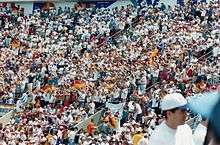
- Although USA '94 marked the seventh time FIFA hosted the World Cup in the Americas (after being held in Uruguay, Brazil, Chile, Argentina, and twice by Mexico in 1970 and 1986), the United States became the first host in continental America outside of the Latin American spectrum, and the first in the Anglosphere outside of England.
- The United States–Switzerland game on June 18 at the Pontiac Silverdome was the first to be played indoors in World Cup history: grass was grown by Michigan State University and was the first time since 1965 (the failed attempt at the Astrodome) that natural turf was used in an indoor stadium in the United States. To date, only Sapporo Dome in 2002 and Arena AufSchalke in 2006 have subsequently hosted indoor games in World Cup history.
- Oleg Salenko of Russia became the first player to score 5 goals in a single World Cup finals game in his country's group stage win over Cameroon. Cameroon's Roger Milla also scored a goal in the same game, becoming the oldest player to score a goal in a World Cup. At 42, he was also the oldest player to appear in a World Cup, a record held until 2014, when Faryd Mondragón (43 years, 3 days) of Colombia broke the record in their game against Japan at the 2014 FIFA World Cup. In turn, goalkeeper Essam El Hadary (45 years, 161 days) of Egypt would surpass Mondragón against Saudi Arabia, in the Volgograd Arena, Volgograd, Russia, on June 25, 2018. However, Milla remains to be the oldest outfield player to perform in the World Cup.
- For the first time, during the entering of the players onto the field, the FIFA Anthem, composed by Franz Lambert, was played.
- Gianluca Pagliuca of Italy became the first goalkeeper to be sent off in a World Cup game, dismissed for handling outside his area against Norway.
- Brazil's 11 goals in their seven games was a record for the lowest average goals scored per game for any World Cup-winning side, but this record was broken by Spain's eight goals in 2010. The three goals Brazil conceded in those seven games was at the time also the lowest average goals conceded per game, although this was subsequently surpassed by France in 1998, Italy in 2006, and Spain in 2010.
- The finals were the first time FIFA decided to experiment with the style of jerseys worn by officials, foregoing the traditional black. They could choose between burgundy, yellow or silver shirts depending on what was necessary to avoid a clash of colors with the two competing teams. This custom has since been followed, but with black shirts added as an option later.
- The finals were also the first time that players had their shirt numbers printed on the center front (or on the right or left breast, in Morocco's and Russia's case respectively) of the shirt, as well as their names printed on the back of their jerseys in a World Cup, just as other American sports did, to make their identification easier for sportscasters. This custom followed from Euro 92, and has followed ever since (although the numbers printed on the center front were experimented during 1991 FIFA U-20 World Cup in Portugal).
- The finals were the first to award 3 points for a win in the group stage to motivate teams to play an attacking style.
- In disciplinary matters, for the first time yellow cards accumulated in the group stage were wiped clean after its completion, and players started with a clean slate at the start of the knockout stage. Previously, players were suspended for one game if accumulating two yellow cards throughout the tournament. Now, players were suspended for one game after accumulating two yellow cards in the group stage, or two yellow cards in the knockout stage. This was in response to the situation in 1990, where players such as Claudio Caniggia and Paul Gascoigne were suspended for the later games.
- The 1994 World Cup revolutionized television coverage of sports in the United States through the sponsored scoreboard and game clock that were constantly shown on screen throughout the game. Television sports coverage in the United States had long been dependent upon commercial breaks, a feature suitable for sports such as baseball, basketball, ice hockey and American football (which all have breaks in the action), but long considered incompatible with soccer, due to the long stretches of uninterrupted play. Variations on it were quickly incorporated into virtually every team sports broadcast by the decade's end. The first American pro sports broadcaster to do this was Fox Sports which won national rights to broadcast the NFL's National Football Conference from CBS six months before the 1994 World Cup began.
- The 1994 World Cup final was the first (and to date only) goalless final in World Cup history. It was also the first to be decided by a penalty shootout, the other being the 2006 FIFA World Cup Final. Italy took part in both games, and won the latter.
- This was the last World Cup in which games other than the last two in each group were played simultaneously, although this only happened once in this tournament: Saudi Arabia v Morocco and Belgium v Netherlands in Group F. From France '98 onwards, each game in the first two rounds of group play and the whole knockout stage have been played separately to maximize television audiences.
- This was the last World Cup featuring 24 nations, and the last in which third-placed teams were still able to progress to the round of 16. From 1998 on, there were 32 nations, with only the top two in each group progressing
- This was the first and the last World Cup , in which both teams, taking parts in third-place final, Sweden and Bulgaria, received bronze medals.
References
- Brewin, John; Martin Williamson (April 30, 2014). "World Cup History: 1994". ESPN.com. Retrieved June 25, 2020.
- "FIFA World Cup™ comparative statistics 1982-2014" (PDF). FIFA. Retrieved June 25, 2020. Cite journal requires
|journal=(help) - Das, Andrew (April 8, 2017). "U.S., Mexico and Canada Likely to Affirm Joint World Cup Bid". The New York Times. Retrieved June 25, 2020.
- "FIFA World Cup host announcement decision" (PDF). FIFA.com. Fédération Internationale de Football Association. p. 2. Retrieved January 30, 2013.
- Czuczka, Tony (July 5, 1988). "History's made, now work begins: U.S. soccer savoring '94 World Cup bid". Seattle Post-Intelligencer. Associated Press. p. D2.
- Cress, Doug (March 13, 1988). "U.S. Soccer officials expect to land 1994 World Cup". The Seattle Times. p. D12.
- Wojciech Dzierzbicki XV FIFA World Cup (USA '94) Archived May 23, 2002, at the Wayback Machine World Cup History Page
- "Funny... It Doesn't Look Like Football" (PDF). Retrieved March 2, 2012.
- Group, Career Communications. "US Black Engineer & IT". Career Communications Group – via Google Books.
- "timeline_of_sun_microsystems_history – Devtome". devtome.com.
- Inc, InfoWorld Media Group (June 13, 1994). "InfoWorld". InfoWorld Media Group, Inc. – via Google Books.
- "WORLD CUP USA 1994: A Tale of Nine Cities". Los Angeles Times. July 10, 1994.
- "THE 1994 BID: How the U.S. got the World Cup". frontrowsoccer.com. March 24, 1992. p. D1.
- "Baseball's key role in World Cup sites". San Francisco Examiner. March 24, 1992. p. D1.
- Chapin, Dwight (March 23, 1992). "Stanford to host World Cup in 1994". San Francisco Examiner. p. A1.
- "World Cup gives Jrs the boot: Miami rejected because of conflict with Marlins". Sun Sentinel. March 24, 1992.
- "WORLD CUP USA 1994: The Best and the Worst". July 14, 1994 – via LA Times.
- "Is Qatar too hot for the World Cup?".
- "US 1994 was a World Cup of scorched feet and sweaty fans". May 29, 2014.
- "The summer that changed U.S. soccer forever". March 4, 2014.
- "FIFA/Coca Cola World Ranking (14 June 1994)". FIFA.com. Fédération Internationale de Football Association. January 27, 2012.
- "FIFA/Coca-Cola World Ranking (14 June 1994)". FIFA.com. Fédération Internationale de Football Association. May 2, 2013.
- Arnold, P. FIFA World Cup USA 94 The Official Book. Pp.12. Collins: San Francisco. ISBN 0-00-255231-0
- "Looking Back at the 1994 FIFA World Cup Draw". www.ussoccer.com.
- "Previous World Cups", FIFA.com. Retrieved November 21, 2013
- History of the World Cup Final Draw FIFA
- "World Cup Hall of Fame – Andrés Escobar (1967–1994)]". CNNSI.com. May 8, 2002. Archived from the original on October 22, 2002. Retrieved June 25, 2020.
- "Divine by moniker, divine by magic". FIFA.com. Retrieved June 12, 2014
- "FIFA World Cup All-Star Team – Football world Cup All Star Team". Football sporting 99. Archived from the original on June 30, 2016. Retrieved June 12, 2014.
- "Romario is legen......dary" Archived January 4, 2014, at the Wayback Machine. Fox Sports. Retrieved November 19, 2013
- Graham, Bryan Armen (June 13, 2018). "USA 94: the World Cup that distracted Americans from Oprah and OJ". The Guardian. Guardian News & Media. Retrieved August 25, 2019.
- "1994 FIFA World Cup USA: Awards". FIFA. Retrieved July 16, 2015.
- "All-time FIFA World Cup Ranking 1930–2010" (PDF). Fédération Internationale de Football Association. Retrieved January 31, 2013.
External links
| Wikimedia Commons has media related to 1994 FIFA World Cup. |
- 1994 FIFA World Cup USA ™, FIFA.com
- 1994 World Cup details RSSSF
- FIFA Technical Report (Part 1), (Part 2), (Part 3) and (Part 4)
- The event at SVT's open archive (in Swedish)
